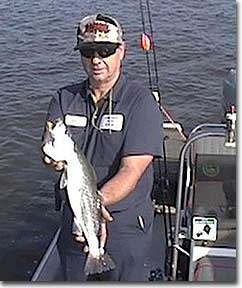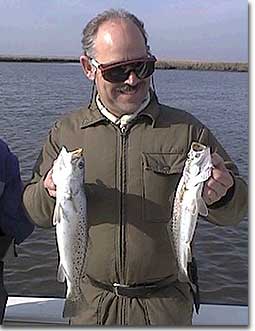Mud Lump Specks
Mud Lump Specks
By Jerry LaBella
Our faces went from a gleeful look to a solemn one as we stared at the steam bellowing from the boat's engine cover. We hadn't made it but two miles down river from the Jump when the disappointing incident interrupted our plans.
 But David Tompkins, a professional photographer and fishing acquaintance, was determined to make it to the Pass A Loutre mud lumps where he limited out the day before on the biggest specks that he had ever seen.
But David Tompkins, a professional photographer and fishing acquaintance, was determined to make it to the Pass A Loutre mud lumps where he limited out the day before on the biggest specks that he had ever seen.
After making it back to the marina, our plans were to get back home and drop off his boat and pick up mine. Three hours later we were back on the road heading south to Venice, Louisiana.
We arrived back at the launch about twelve-thirty a.m., and thirty minutes later I was flashing the spotlight along the banks of an inconspicuous and unfamiliar pass located off the Mississippi River.
As the boat made its way down the waterway, a wall of ten-foot-tall canebrakes lined each side. For miles the 12 foot wide pass cut through the canebrakes, and in some places it got so narrow that the boat's sides grazed against them.
Things were going well, up until the time we noticed amber glowing reflections on the water's surface. It turned out to be the eyes of many alligators reflecting the beaming spotlight as they scurried across the pass. At this point we were both justifiably nervous, hoping a repeat of earlier wouldn't plague us now.
Thirty-five minutes later we entered the waters of the Main Pass Blocks where we proceeded to anchor down to rest until daybreak. At this point, according to David, we weren't very far from the Pass A Loutre mud lumps.
Within a matter of minutes of our waking up, we were soon headed south and around the peninsula toward the southern arm of Pass a Loutre. David expressed some concern that the mud lumps would be difficult to pinpoint due to calm winds and high tide. Under these conditions the telltale rippling effect that often surrounds them, and which is sometimes mistaken for surface bait activity, might not be so obvious.
Nevertheless, the depth finder indicated we were fast approaching a shoal, having just passed over surrounding depths of 15 feet. The water appeared a discouraging color, but David affirmed that this was the same conditions as the day when he and a friend limited out on monster-sized specks.
Encouraged by the affirmation, both lines were cast into the calm waters and the minnow lures readily contacted bottom, evidenced by a suction-like feel at the end our rod tips when lifted.
We had found them; the Pass A Loutre mud lumps. This is the place that I had heard so much about but had never fished before. In the distance, rising above the thick canebrakes along the beach, the top of the old abandoned lighthouse situated at the fork of Pass A Loutre could scarcely be seen.
After twenty minutes of fishing and being fooled by simulated strikes from the sticky clay bottom, I couldn't help but wonder if his fishing story wasn't a little over exaggerated.
 Admittedly, this area did have a distinctively different air about it. Unlike the more familiar mud lumps of South Pass, where several stand well above the water's surface, here it was to the contrary.
Admittedly, this area did have a distinctively different air about it. Unlike the more familiar mud lumps of South Pass, where several stand well above the water's surface, here it was to the contrary.
Fortunately by the time we decided to move, the wind picked up just enough so that in the near distance we were able to visibly identify a couple of mud lumps. Here the telltale signs were quite obvious, having wavelets dancing all about them. We pulled up between the two, carefully positioning the boat down current.
Casting between the mud lumps, we allowed the chartreuse, silver flick, black-back minnow lures to sink to the bottom as we retrieved slowly enough to keep up with the current flow, thereby eliminating unwanted slack in our lines. Halfway to the boat both rods buckled in two, almost in unison, while the drag ratchets produced a loud whizzing solo.
A minute later two surprisingly large speckled trout flopped across the deck, vigorously battering it with their broad, black, spotted tails. Not wasting any time, two more casts shot forth from our reels. Once again, halfway to the boat a repeat of the same thing took place.
By nine-thirty a.m., the 155-quart ice chest was almost filled to the top. We were flabbergasted at the amount of speckled trout in such sizes. Several over six pounds, at least ten at or near five pounds, and the remainder of the limit between three and four and-a-half pounds. Now don't get me wrong, we've seen trout this size before, but not as plentiful. To emphasize the point, a normal-sized limit for three anglers would have only filled this size ice chest halfway.
But this is not entirely unusual, for it's no secret that the delta has long been known for its excellent speck fishing, especially at locations where the many passes empty into the Gulf. However, only a select few ever consider fishing these particular mud lumps. The main reason perhaps is that they are more difficult to access, for instance, than the more popular South Pass mud lumps which receive a lot more fishing pressure.
It's interesting to note, too, that few anglers even know what delta mud lumps look like, let alone how they are formed.
The operative forces behind the formation of the mud lumps are the water pressures from the deep waters off the nearby continental shelf and the powerful Mississippi River. These conflicting pressures are said to squeeze the sandy sea bottom causing the clay strata to literally pop up through it. The process is continually ongoing and is influenced by hurricanes and other severe weather. Consequently, over a period of years the mud lumps take on different forms, coming and going from one location to another. Naturally this is most obvious with respect to those above the water's surface; a good example of this is the South Pass mud lumps, as seen in the following picture.
The mud lumps themselves look much like gray-colored, flat-topped, jagged mountains, and those below the water's surface have a creamy potter's clay consistency. Anglers who have ever anchored on top of the mud lumps know well how hard it is to remove this clay from their anchor flukes.
Another thing that isn't as well-known is that these fish-attracting mud lumps also exist near various other delta passes, but are not as conspicuous in that most often they lie hidden below the water's surface, even on low tides. This might be one reason why maps do not acknowledge their existence.
The Pass A Loutre mud lumps were only recently discovered. One day a local charter boat hit bottom while returning back to the mouth of the Pass after fishing offshore in the Main Pass Blocks. While the boat was sitting there stranded for awhile, a bored and unsuspecting angler picked up his fishing pole and made a cast. To his amazement he landed the biggest speckled trout that he had ever seen. In a matter of minutes the rest of the charter crew joined in on the action, landing monster-sized specks one after another. The charter captain later realized that he had gotten stuck on a submerged mud lump.
As you can imagine, a story this hot couldn't be kept secret long, but there was one catch to it- the trek back to this spot for most anglers wouldn't be so easy.
The irony of it all is when you're looking at a map it seems to be very accessible via Pass A Loutre, a broad and straight waterway like that of the lower Mississippi River. But don't be deceived, though passable via its southern fork, this is one of the most tricky waterways of the delta. Filled with sporadically located concrete-like sandbars, some of which lace the middle, few anglers are willing to take the chance of running a ground and bending a prop or shaft. It is no wonder why some have fittingly nicknamed it "Pass If You Can." It is this very reason that makes the Pass A Loutre mud lumps so fruitful in comparison to those that are more accessible.
But all is not lost, there is an alternate route that is relatively easy to run and parallels north of Pass A Loutre. On the map it is identified as Raphael Pass. Taking this pass To Joe Brown Pass will even be quicker, as it junctions back to Raphael Pass, making the route straighter. This is the same route that we took. If you choose to take this route, bring an aerial photo map and mark the route so that when you return you won't get lost at the forks. As far as the alligators, don't worry about them, they're generally never seen by day.
But if the Pass A Loutre mud lumps sound too intimidating to tackle, try the South Pass mud lumps, located on the west side of its peninsula in East Bay. The trout here are just as large but not as plentiful, though limits can be had if you know how to properly fish them.
Anglers fishing from boats with trolling motors are frequently seen around mud lumps, and it appears that they have the most success. The key is to cover more ground, working the drop-offs around the mud lumps starting with those above the water's surface.
The submerged mud lumps therein are also productive, but you'll need a depth finder to locate their ledges if the winds and current are too weak. However, these mud lumps, which are brushed by the currents of the Gulf and East Bay, ordinarily produce enough under water movement to yield the needed surface commotion to give them away, even in the calmest of weather.
Here the freshwater intrusion from the river has little significance on the deeper saltwater located below; so even if waters appear murky on the surface, you can be assured that this won't impede the fishing if there is a good incoming tide. So influential are these currents at the South Pass mud lumps that at times it will cause the green Gulf waters to surround the mud lumps alone, while the rest of the area for miles exhibits chocolate-colored freshwater runoff on the surface.
Likewise, due to the currents, another phenomena that transpires is when two-foot wide lines of brownish river water streak through the clean, green Gulf water of this location in a way that resembles fudge ripple ice cream. This is most pronounced when the river stage is about mid-range of its peak, sometime in late winter or early spring.
The churning currents that envelope these mystical mud lumps no doubt churn up bait fish in such away that they alluringly draw predator fish, including the much sought after monster-sized mud lump specks!
|
